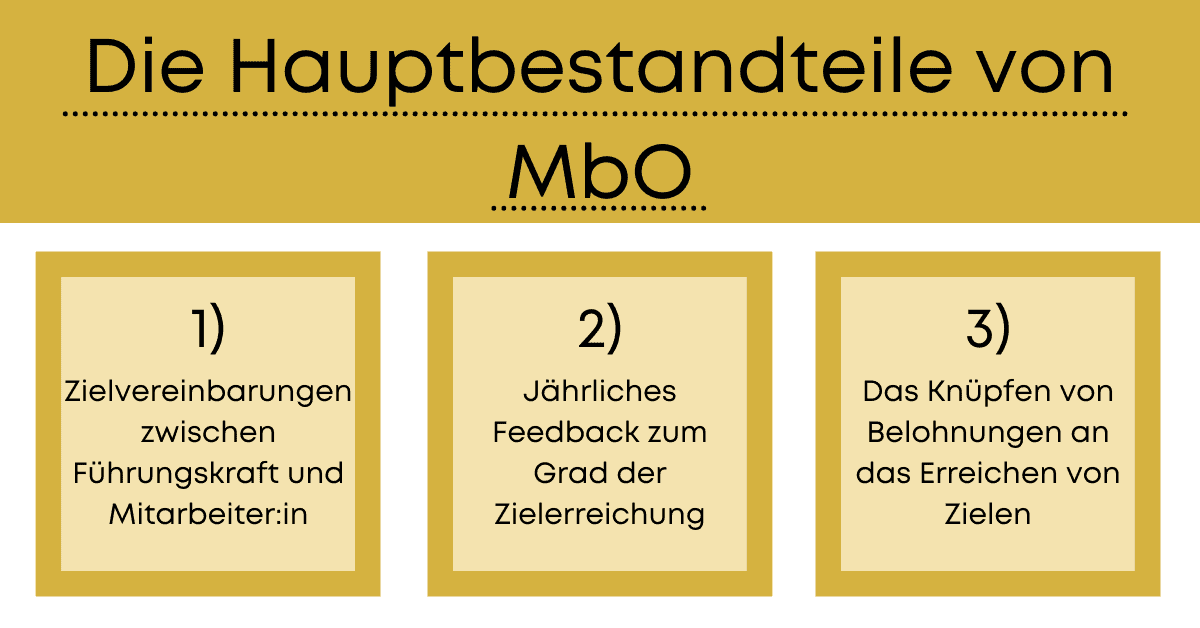MbO – Management by Objectives – definition, examples, advantages and disadvantages & modern alternatives
Management by Objectives – MbO for short – revolutionized the management world at the time. It quickly became one of the most popular methods for goal setting.
Below you will find a brief definition as well as information on the origin and basic principle of MbO. In addition, the advantages and disadvantages of the method are shown and the difference to other concepts is clarified.
OKR (Objectives and Key Results) – the successor to MbO – originally called Intel Management by Objectives (iMbO)
We, the OKR experts, will be happy to support you with the introduction of OKR. Based on the MbO concept, Andy Grove, CEO at Intel for many years, developed OKR – Objectives and Key Results in the 1970s, which he initially called “iMbO – Intel Management by Objectives”.
- Field-tested implementation process
- Avoid mistakes, reduce effort
- Manage the coexistence of MbO and OKR correctly – or replace MbO with OKR
- Top rated seminars & workshops
- Support in selecting an OKR tool
Management by Objectives Definition
Management by objectives corresponds to transactional leadership. The method was developed in 1954 by US economist Peter Ferdinand Drucker in his book
The Practice of Management
published in 1954. Goals and goal achievement have thus become central aspects for and in companies by definition.
The aim of MbO is to promote teamwork and to bring the company’s goals down to employee level. The method is also intended to give employees some room for personal responsibility and individual measures to achieve their goals.
MbO goals for marketing can look like this, for example:
- Doubling the number of subscribers to our newsletter
- Increase in visitors to our websites by 40 percent
Here are some examples of MbO targets in personnel development:
- Maintain employee satisfaction at over 89 percent
- Introducing a training program for managers
Employees can now take individual measures to achieve these goals.
The basic principle of MbO
The following illustration shows the main components of the MbO concept:
These points 1 to 3 are examined in more detail below.
Target agreement
Companies that use MbO usually set targets for one year. Targets are set at company level at the end or beginning of the year. Targets for the departments and teams are derived from these. Target agreements are made between superiors and employees with these overarching goals in mind.
A target is deemed to have been achieved if the degree is 100 percent or higher. Overfulfillment is often sought.
Management by objectives and SMART objectives
It is important that the objectives are SMART in order to derive the objectives that managers set with their respective employees. SMART helps with the conception and formulation of goals and helps to define good goals. This is important for measuring target achievement.
It is often used when targets are formulated as part of target systems such as management by objectives (or OKR). SMART is an acronym introduced by George T. Doran in 1981 – it is made up as follows:
- Specific – i.e. concrete and clear formulation of the objective
- Measurable – i.e. clearly measurable
- Achievable / / Achievable i.e. appealing, desirable and feasible
- Reasonable/Relevant / Appropriate – i.e. important and comprehensible
- Timebound / Scheduled – i.e. with a clear time limit
Only with clear objectives can success or failure or the degree to which objectives have been achieved be measured objectively. This is very important, because MbO is usually about a bonus, salary increase or promotion, which should not be subject to arbitrariness.
Feedback on target achievement
The annual review does not assess an employee’s actual performance. Rather, it checks whether the individual goals agreed between employees and managers have been achieved – also with regard to the overarching corporate goals.
This is determined on the basis of the degree of target achievement. If 100 percent or more of the agreed targets are achieved, employees receive the corresponding reward.
Rewards for achieving targets
In MbO, the achievement of goals is linked to rewards. These can be bonuses, salary increases or promotions. The motivation here comes from outside – the so-called extrinsic motivation.
The prospect of rewards can have a motivating effect, but can also encourage problematic behavior among employees (for more information, see the section on the advantages and disadvantages of MbO).
We support you in the introduction of OKR, in OKR training and in optimizing the use of OKR in your company.
Prerequisites for the successful introduction of management by objectives
Some criteria must be observed for management by objectives to work successfully:
- Overarching corporate goals must be in place
- These targets must be regularly reviewed and adjusted if necessary
- Measurable sub-goals must be derivable from these goals
- Transparent and direct communication between all managers and their respective employees
- A suitable incentive system: premium, bonus, salary increase and promotion
- Sufficient room for maneuver for employees to achieve their goals
- Appropriate assessment methods for determining the success or failure of objectives and key results
Advantages and disadvantages of MbO (Management by Objectives)
(Table can be scrolled horizontally on smartphones)
| Vorteile | Nachteile |
|---|---|
| Fokus auf Ziele: Mit dem Ansatz, Ziele in den Vordergrund zu stellen, revolutionierte Peter Drucker die Management-Welt. Immer mehr Unternehmen setzen seitdem auf Zielsysteme. | Extrinsische Motivation: Prämien für die Zielerreichung klingen verlockend, können langfristig aber viel Negatives bringen. Es können Interessenkonflikte entstehen, weil Mitarbeitende egoistisches, opportunistisches Verhalten entwickeln. Außerdem können Mitarbeitende die Neigung entwickeln, ihre Ziele so niedrig wie möglich anzusetzen. Heruntergehandelte Anforderungen ermöglichen es, schneller die Belohnungen zu bekommen. Eventuell entsteht eher Konkurrenzdenken anstelle der angestrebten Teamarbeit. Darunter leidet auf lange Sicht die Qualität der Arbeit. |
| Unternehmensziele erreichen die Ebene der Mitarbeitenden: Indem die Unternehmensziele für die Belegschaft öffentlich gemacht werden, können alle Tätigkeiten auf diese Ziele ausgerichtet werden. | Zielerreichung ab 100 Prozent: Die Motivation, Ziele zu 100 Prozent zu erreichen, schöpfen Angestellte aus der Aussicht auf Prämien. Diese beiden Aspekte können bewirken, dass die Mitarbeitenden ihre Ziele herunterhandeln, um schneller an die Belohnung zu kommen. |
| Mitbestimmung bei der Zielsetzung: Dass Mitarbeitende ihre persönlichen Ziele und Ideen mit einfließen lassen können, hebt ihre Motivation. Sie können sich mit diesen Zielen identifizieren und sie erfüllen sie wie persönliche Ziele. | Kontrolle notwendig: Durch die Freiheiten in der Gestaltung der individuellen Maßnahmen muss der Fortschritt der Mitarbeitenden durch Vorgesetzte kontrolliert werden. |
| Eigenverantwortung und individuelle Initiativen: Die Mitarbeitenden können selbst entscheiden, auf welche sie Weise ein vorgegebenes Ziel erreichen möchten. Dies gibt ebenfalls Motivation und ein Gefühl von Mündigkeit. | Hoher Abstimmungsaufwand: Jede/r Mitarbeitende setzt im Einzelgespräch mit der Führungsebene die einzelnen Ziele. Weil dies ein relativ großer Aufwand ist, werden die Zielvereinbarungen im Laufe des Zyklus meist nicht noch einmal angepasst - maximal in einer halbjährlichen Überprüfung. |
| Entlastung für Führungskräfte: Da die Mitarbeitenden eigeninitiativ Maßnahmen zur Zielerreichung erarbeiten und durchführen, muss der Vorgesetzte nicht die Aufgaben/Tasks verteilen. Er muss zu Beginn des Jahres nur die Zielvereinbarung treffen. | Jährliche Kontrolle der Zielerreichung: Dass die Zielerreichung jährlich, manchmal halbjährlich stattfindet, kann einen starken Mangel an Agilität bedeuten. Spontane Kurskorrekturen als Reaktion auf überraschende Ereignisse sind auf diese Weise nahezu unmöglich. |
The dangers of management by objectives
With management by objectives, there is a risk that managers will not set the right targets. In some cases, managers set targets that do not serve the company’s purpose and are hardly ambitious. Sometimes employees exceed their targets without checking or knowing whether they were important.
Management by objectives is very rigid and not really agile due to the annual cycle. This means that MbO cannot react to rapid changes. With MbO, it is very difficult to bring new innovations and adapt. The successor Objectives and Key Results is better suited for this purpose.
Further examples of management by objectives
Here are some examples of how management by objectives can be used in different departments.
Examples of management by objectives in business development
- Achievement of a cash flow of 500,000 euros per month
- Increase in the customer retention rate to 92.5
- Increase in gross margin by 10
Examples of management by objectives in marketing
- Increase in marketing ROI by 7.5
- Tripling the number of followers on social media
- Doubling of newsletter subscriptions
Examples of management by objectives insales
- Achieving a return on sales of 20%
- Achieving an average deal size of 15,000 euros
- Shortening the sales cycle to 3 months
Management by objectives – examples from the HR department
- Increase in the Employee Satisfaction Index (ESI) from 85% to 90%
- Maintaining remuneration that is 10 % above the industry average
- Conducting at least three interviews for new marketing employees
Examples of management by objectives in software development
- Increase the speed of the system architecture by 25%
- Maintaining an uptime/availability of the system architecture of 99.9%
- Participation in a hackathon
Examples of management by objectives in product management
- 20% increase in subscriber sales
- Maintaining a CSAT value (customer satisfaction) of 85
- Maintaining a Net Promoter Score of 80
Management by objectives – examples of customer success
- Shortening customer onboarding to three days
- 20% higher customer satisfaction with the onboarding process
- Collaboration with the sales department to increase cross-selling by 10%
Examples of management by objectives in customer service
- Reduction in call abandonment to 3.5 %
- Completion of 5 new scripts for customer service
- Reduction of the incidence rate by 25
Management by Objectives Examples Finances
- Support in raising new funding of EUR 1,000,000 through investment preparation
- Completion of financial planning and sales forecast
- Development of an annual operating budget
Examples Management by Objectives operational business
- Preparation of an annual operating plan
- Reduction of the software test time to one week
- Reduction of 5% in product procurement and logistics costs
OKR: the successor to MbO
Peter Drucker’s MbO concept developed into the modern OKR method in the 1970s. Andy Grove, who was Executive Vice President of Operations at chip manufacturer Intel at the time, initially called his method “iMbO – Intel Management by Objectives” and only later OKR – Objectives and Key Results.
(Table can be scrolled horizontally on smartphones)
| MbO | OKR | |
|---|---|---|
| Zielebene | Einzelne Mitarbeitende | Unternehmen, Abteilungen, Teams |
| Zielvereinbarung | Einzelgespräche zur Zielvereinbarung zwischen Führungskraft und Mitarbeiter:in (top-down) | OKR-Sets auf allen Ebenen, top-down, bottom-up, cross-department/Team |
| Zielerreichung | 100 Prozent, sogar Übererfüllung | 70 Prozent (für ambitionierte Moonshot-Ziele) |
| Statusmeetings | Jährlich, manchmal halbjährlich, selten pro Quartal | Tägliche Check-ins (Daily Huddles), wöchentliche Reviews (OKR-Weeklys), einmal pro Zyklus, meist ein Quartal (OKR-Review) |
| Planung | Jährlich | Meist Quartalsweise oder kürzer (2 Monate) oder länger (4 Monate) |
| Transparenz | Mitarbeitende kennen nur ihre individuellen Ziele und die übergeordneten Unternehmensziele | Unternehmensweite Transparenz: alle OKR-Sets sind allen Mitarbeitenden bekannt |
| Orientierung | Output-orientiert, d.h. Resultat-orientiert (abgeschlossene Aufgabe, Projekt: ohne den Nutzen zu hinterfragen) | Outcome-orientiert, d.h. Ergebnis-, Nutzen-, Wirkungs- und Wertbeitrags-orientiert |
| Motivation | Extrinsisch über Belohnungen, wie Prämien / Boni, Gehaltserhöhungen oder Beförderungen | Intrinsisch durch Arbeit, deren Sinnhaftigkeit, Nutzen und Wirkung erkennbar ist. Durch Autonomie, durch das Streben, sich in dem zu verbessern, was man tut |
Summary: Management by Objectives – OKR’s little brother
Management by Objectives reformed the management world in its day. As his successor, OKR has adapted to the requirements of today’s times and the mindset of the younger generation, which is increasingly striving for self-realization and a sense of purpose.
Here is a summary of the most important points:
- Management by objectives focuses on goals. It aims to give employees the freedom to design measures to achieve goals.
- Rewards are intended as an incentive. However, this can lead to problematic behavior among employees and to conflicts of interest.
- OKR is the successor to MbO. In terms of agility, OKR has an advantage: regular reviews in shorter cycles also enable short-term course adjustments.
- OKR is also ahead in terms of employee motivation. The framework relies on intrinsic motivation instead of extrinsic material incentives.
- OKR handles objectives more transparently than MbO – this creates better coordination and avoids duplication of work.
- Overall, the OKR method is better equipped for today’s VUCA world than management by objectives.






